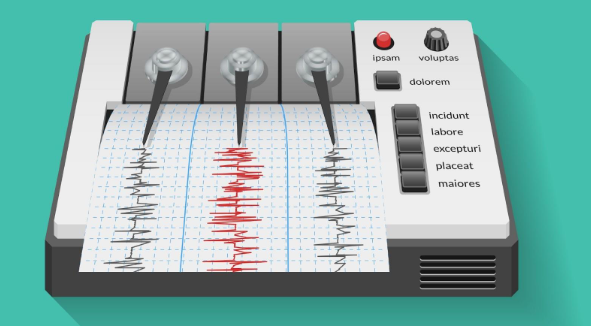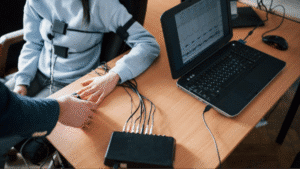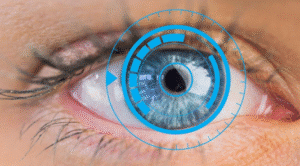Choosing polygraph equipment is a critical decision. While options abound, you want a machine that can capture the examinee’s physiological responses with remarkable accuracy.
Note that polygraph question design rules require flat Yes or No replies. Even so, a lie detector machine should analyze each response correctly to provide a reliable indication of the examinee’s truthfulness or deception.
Using substandard equipment could have an innocent suspect indicted while a guilty one walks scot-free. The wrong machine may also return an inconclusive verdict, wasting both the polygrapher’s and examinee’s precious time.
To select the most reliable lie detector equipment, determine whether it’s analog or computerized. Each option has its unique benefits and drawbacks.
Here’s a detailed guide on how analog polygraph machines compare with their computerized counterparts.

What Do Polygraph Machines Measure?
Polygraphs measure certain physiological changes associated with deception. Those include heart rate, breathing, blood pressure, and skin conductivity. The human brain interprets lying as an existential threat. Therefore, it activates a chain of physiological responses to deal with the imminent threat.
Lying stimulates the autonomic nervous system (ANS), a division of the nervous system responsible for controlling several involuntary activities. An aroused ANS causes changes in all four key parameters measured by lie detector machines.
According to the industry’s guidelines, polygraph sessions should occur in three critical stages, all conducted in the same session – the Pre-test Phase, In-test Phase, and the Post-test Phase.
Each session begins with the pre-test phase. This stage entails preparing the examinee mentally for the real questioning.
The pre-test phase enables an examiner to establish a rapport with the examinee, obtain their informed consent, and measure their physiological baselines. Examiners can then compare each reply to in-test questions against the pre-established baselines to accurately infer deception or truthfulness.
Essential Components of Polygraph Machines
Lie detector equipment comprises three principal components, namely;
a) Cardio-sphygmograph
Cardio-sphygmographs consist of blood pressure cuffs. During the in-test phase, an examiner wraps the cuffs around the examinee’s arm to monitor blood pressure and heart rate changes.
b) Pneumograph
Pneumographs measure an examinee’s breathing by their simple expansion and contraction. It comprises hollow rubber tubes with a spring inside that are wrapped around the subject’s chest and abdomen, tracking significant fluctuations in thoracic pressure.
c) Galvanograph
Galvanographs come with electrical sensors that measure the quantity of sweat produced while responding to lie detector questions. Examinees can track fluctuations in skin conductivity that are consistent with deception.

Analog Versus Computerized Polygraphs
1. Definition
Analog lie detector tests were the earlier-generation polygraph machines. These machines utilize mechanical components to record the four ANS-regulated physiological responses associated with lying.
Computerized polygraphs, also called digital polygraphs, rely on computer hardware and software. Responses are digitally captured, visualized, and stored.
Computerized lie detector machines emerged in the ‘70s. However, the technology received widespread attention in the 1990s and has evolved tremendously since then.
2. Operation
Both analog and digital polygraphs follow a general operational mechanism.
Typically, an examiner connects different attachments comprising in-built sensors to an examinee’s body. Each sensor captures data on specific physiological reactions to the in-test questions.
However, the two generations of polygraph equipment differ in their data collection methodologies.
Analog lie detector machines utilize hollow metal tubes, called pens, to transfer ink to the chart paper that is pulled along beneath these pens by a chart drive mechanism. Changes in physiological reactions are transmitted from the pneumograph’s pneumatic tubes, as well as from the other sensors, to the pens to create a composite graph. Each graph represents the level of deviation from the pre-recorded baselines, with a significant difference in the patterns potentially indicating deception.
Meanwhile, computerized polygraphs utilize computer hard disks and software to record examinee’s responses. The hard disk captures each reply, which is then displayed on the screen or printed out.
The software programs used by digital polygraphs are powered by advanced algorithms for improved data accuracy.

3. Comparing the Benefits
Analog polygraph machines are presumably cheaper than their digital counterparts. They also don’t require software downloads, system configurations, or regular updates.
However, this shouldn’t be misconstrued as being easier to use. On the contrary, analog polygraphs require a steeper learning curve to master. Examiners must constantly adjust the mechanical components and monitor the ink flow, which can be annoyingly tedious.
It’s also worth noting that current polygraph standards require using motion sensors. Unfortunately, most analog lie detector machines lack the provision for integrating motion sensors.
Other Benefits Of Digital Polygraphs
Computerized polygraph machines provide superior accuracy. The equipment enables examinees to analyze data more precisely, improving the reliability of each polygraph test.
NOTE: Merely having the right machine won’t guarantee a credible polygraph exam. To improve the test’s accuracy, examiner experience is equally critical.
Digital polygraphs also foster seamless data management. They let you visualize, store, and share the collected information from a single platform. That’s in contrast to analog machines, where the polygram may be damaged by careless handling or adverse weather.
Besides, computerized polygraphs facilitate real-time feedback. This renders the process less subjective. It also enables examiners to make informed decisions during in-test interviews, such as switching to irrelevant questions to let the examinee catch their breath.
Digital polygraphs streamline report preparation, too. Instead of carrying bulky polygrams to the courtroom or a therapy center, readily print out the report or share it digitally with all concerned parties. Even better, you can store the report in a tamper-proof cloud ecosystem for future reference.

Optimizing Polygraph Accuracy With Computerized Lie Detector Tests
Analog polygraph machines may be somewhat cheaper, making them ideal for entry-level independent polygraphers. But there’s a costly price to pay in terms of long-term reliability.
Note that polygraph reports can have far-reaching implications on an examinee’s career or reputation. Therefore, it’s imperative to select a machine that provides unmatched data visualization.
Computerized lie detector equipment utilizes advanced algorithms that record and analyze the examinee’s responses in split seconds. Polygraphers receive real-time feedback, enabling them to implement appropriate in-test changes for better outcomes.
Sure, digital polygraphs may come with a hefty price tag. But as a trade-off, they let you conduct lie detector tests that meet the industry’s accuracy benchmarks.






